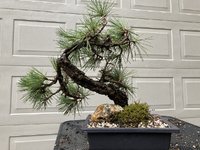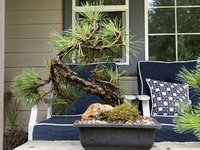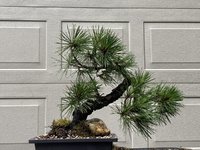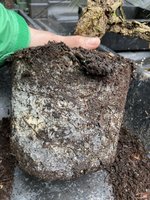Potawatomi13
Imperial Masterpiece
Possibility of fellow club member with cold greenhouse and willing to house for Winter may exist for you ?
?
Ran into this problem more than once myself. If a tree is new to me and in moisture retentive substrate I tend to remove as much as I can in the spring when repotting while still leaving the core rootball intact.6/24-26. High temperatures, intense sun that came on quickly. Kept pines in full sun. Covered the sides of the pots to keep temperatures down around roots. Older needles appear to be yellowing.
Since it was so hot, the temptation to water the trees was strong, especially for the one that had substrate added to its pot. But when I checked moisture levels, the added pumice was dry and the original rootball was still wet. So I did not water.
Piggy-backing off a comment in another thread…
I believe this is a good example of a possible complication from adding new substrate when slip-potting. If the added medium differs from the original, it will have different drainage properties and could give a false impression of moisture content actually around a trees roots.
I tend to believe that fungi doesn't grow on healthy tree bark. Lichens (alga-fungi symbionts) yes, but those mushrooms aren't lichen-like.Found these tiny mushrooms growing on the bark of one tree. It has been very wet and mild here recently..
There does not appear to be any rotting. Perhaps some organic matter is building up in the bark folds and crevices.
A good point.I tend to believe that fungi doesn't grow on healthy tree bark. Lichens (alga-fungi symbionts) yes, but those mushrooms aren't lichen-like.
I'm not sure about this case, but most of the fruiting bodies seem to be like armpit hairs. So, I'm very skeptical about the idea of organic material accumulating in bark fissures. To me, it seems much more likely that there's is dead tissue beneath that bark plate framed by the mushrooms. I don't want to believe that any more than you do, but (after spending a suitable length of time in denial) I think I would pop that plate off and look closer. And, I imagine I would wind up 'cauterizing' that area with my butane torch with it in mind that this is an effective treatment of 'rot fungi'. So doing, I've maybe just created another bonsai feature - if I'm wrong, it eventually gets cut off which is pretty much the only alternative treatment.
The other path is to 'hope, hope, hope' that it isn't true. If it turns out that the mushrooms are back next year ...


Did you do a half bare root?View attachment 474136
A club member helped me repot this tree. 1st one in 15 years. It went into 1:1:1 aka lava pumice.
Roots looked mediocre. No surprise given how broken down, wet, and organic the previous soil was.
I know everyone’s thinking it so I’ll just say it……that graft union looks silly. It’s like the trees wearing corset.
You have corkers on their own roots?That's some nasty soil. Keep close tabs on the moisture content of that nursery soil this year. It doesn't take much for root rot to take hold with corkers. I find their root systems considerably weaker than regular JBP.
















My goals are to grow the tree larger, get it into better substrate before the root mass spreads too much, and remove a leader to prevent more swelling where the two originate.Ondae gets good corky bark pretty fast, but the growth pattern is very angular. I didn’t have good luck summer candle-cutting so the needles got longish, but it is a good cultivar. Have fun with It.
